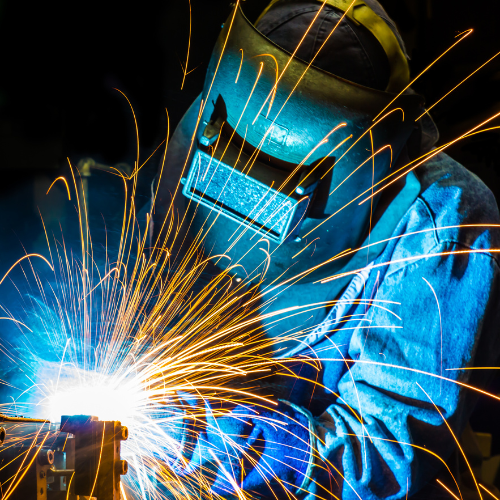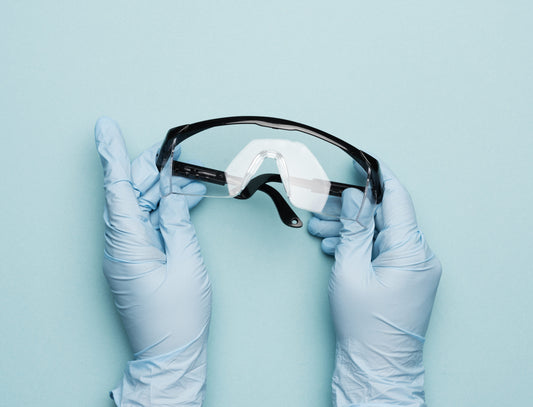
Welding With an Air Filter/Respirator: List of Options with Pros and Cons
Anyone in the fabrication or construction industry knows the challenges of dealing with air quality onsite. The air we breathe is never 100% clean. We’re always picking up trace elements of environmental substances as we move and breathe; however, once air contamination passes a specific threshold, it is recommended (and even mandatory in the workplace) to use some air filtration device. When your job involves dealing with poor air quality or particle-filled air, it doesn’t mean you must inhale contaminated air. It means wearing the right equipment to keep yourself safe and healthy.
When it comes to welding, safety should always be a top priority. One of the most important safety measures is wearing an air filter or respirator while welding to protect yourself from harmful fumes and particles. Many options are available regarding air filters and respirators, each with pros and cons. For example, disposable respirators are cheap and easy to use but may not provide as much protection as a more expensive option like a powered air-purifying respirator (PAPR). Additionally, it’s important to keep your welding helmet in good working condition to ensure maximum protection. The guide to welding helmet replacement Parts can help you find the right replacement parts for your helmet, including lenses and headgear.
Most safety training will discuss air quality, respirators, and lung protection. Nevertheless, revisiting air-quality safety and reevaluating the workplace is always helpful to ensure proper precaution and protection. One particularly challenging workplace task is welding in an environment of poor-quality air. Such environments require relevant welding PPE, with the addition of proper air filtration equipment.
Combining a welding helmet with a respirator requires equipment specifically designed to work in tandem; a respirator alongside a helmet.
Here are some options for protection against contaminated air while welding.
Helmet and Disposable Particulate Respirator
Combining the welding helmet with a basic disposable particulate respirator is the most common. Disposable respirators are what you generally see around a workplace where only specific tasks at specific times require air filtration. These products are made to be used once or maybe twice before being thrown away (always consult the manufacturer’s instructions).
Disposable respirators (non-disposable will also meet this classification) generally have the designation “N95”. They meet health and safety standards for most workplace scenarios and filter out 95% of airborne particles. N95 respirators are the most common since they provide adequate protection for most tasks.
A welding helmet combined with a disposable N95 respirator will provide adequate protection for most tasks encountered in the workplace, but the combination also has certain limitations and downsides.
Pros
- General Application–setup will work for most workplace situations.
- Cost Effective–disposable N95 respirators are cheap, provided they are used infrequently.
- Ideal for a large workforce with infrequent use–where other welding/air filtration combinations require a more upfront cost, the disposable option offers adaptability. One worker needs a mast for a specific task one day, and another worker needs a mask for some other job the next. Disposable masks mean that each worker can have adequate protection against air contamination when they need it at a low cost.
- Adaptability–disposable N95s will fit comfortably under most welding helmets, making them a simple add-on for relevant tasks.
Cons
- Disposable–products break down fast. While acceptable for a single task over several hours or even a day, disposable respirators are not designed to maintain their integrity over time with regular use. It is recommended that used masks are discarded and new ones used if a task will take more than a single day..
- Saturation––in heavily contaminated environments with elements such as dust, masks quickly become saturated and require frequent replacement.
- Uncomfortable–Disposable N95s can be uncomfortable over several hours of use. Since elastic bands around the ears usually hold them in place, they can become painful or irritating for the wearer after hours of use.
Bottom Line
The disposable N95 respirator and a welding helmet are good temporary solutions. It is ideal for situations where air quality is only infrequently a factor in the workplace. If air filtration is regularly required while welding, a more permanent solution might be in order.
Helmet and Non-Disposable Respirator Combination
Combining a welding helmet with a non-disposable respirator is the second option. The helmet-non-disposable mask combination would provide adequate protection for any general-purpose situation but is also customizable for situations that require more rigorous protection.
However, this combination can become more complex since the user must carefully choose a respirator that fits comfortably below the welding helmet. Generally speaking, non-disposable respirators will be more rigid than disposable ones. Rigidity allows them to have longer lifespans but can limit their use for welding purposes. So, should you opt for this combination, choose a respirator that fits comfortably under your helmet.
That said, here are the relative pros and cons of this particular setup;
Pros
- Durable–the helmet-non-disposable respirator setup is ideal for scenarios where the individual regularly requires a respirator. Since reusable respirators are built for regular and repeated use, they are more durable and cost-effective in the long term than disposable respirators.
- Customizable–most reusable respirators can be customized to the task. Usually, this means the use of different filter pads adapted to the specific air contaminant encountered. Some reusable respirators also provide the option for protection against gaseous contamination.
- Comfortable–reusable respirators are designed and built for regular and repeated use. Rather than simply looping behind the ears, reusable respirators generally attach behind the head for a comfortable and secure fit that does not become painful over time.
Cons
- High Upfront Investment–reusable respirators are more expensive than disposable options. This is why they are more suited for workers regularly encountering contaminated air. Combined with a welding helmet, the price can mount fast.
- Individual–a box of disposable respirators will serve a large workforce as needed. A reusable respirator will serve an individual well and last long.
- Rigidity–while it can be a feature for durability, rigidity can also become a bug when the respirator needs to adapt to specific helmet types. Again, ensure your welding helmet is compatible with the reusable respirator you purchase.
Bottom Line
Reusable respirators are highly customizable, enabling them to serve in situations where prediction is provided beyond the N95 classification. Combined with a welding helmet, they are more comfortable in the long term. Over a long enough period, they are also more cost-effective, provided the same individual is working on the same task.
Single Unit Helmet and Respirator
The final option is the welding helmet with a built-in respirator. These units are designed and manufactured for scenarios where welding is required in contaminated environments. They bring all the benefits of specific design, from comfort to functionality. They are customizable through the use of different filters. They are also highly durable.
These units are the best option for those regularly working with contaminated air. Another option might make more sense for those requiring air filtration sporadically.
Pros
- Specific Design–Helmets that contain respirators are simply the best option for welding in contaminated environments. They fit comfortably, are built for longevity, and provide flexibility and view alongside super protection. Because they are designed together as a unit, there is no need to worry about the respirator working with the helmet.
- Quality–most helmet-respirator units boast high quality. They will last longer than the other options on this list and do their job well.
- All-Round Protection–built-in respirator helmets provide adequate protection for nearly any situation that might be encountered. With filter options for both particles and gas, they can be customized for all welding environments.
Cons
- Specificity–a helmet with a built-in respirator is a specific product. Most welding tasks will not require such rigorous protection.
- Price Tag–these units generally cost more. That’s why they’re a good option for those requiring a helmet/mask combination regularly.
Bottom Line
Built-in respirator helmets are built exactly for welding in air-contaminated environments. They are ideal for those whose jobs often require such protection. The adage “the right tool for the right job” appropriately applies to these units. For some jobs, they’re exactly what you need.
Final Comment
Welders working in contaminated air environments must wear some form of air filtration device. The choice of device depends ultimately on the environment and the specific situation. For one-time use, a disposable respirator can be combined with your welding helmet for a simple and cheap solution. However, a more permanent option might be more appropriate if a respirator is regularly required.
Regular-use options range in price, comfort, and functionality. A cheaper option is the purchase of a respirator to fit under your helmet. The welding helmet with a built-in respirator is a pricey but probably more comfortable and secure option.
Whatever your choice, always put safety first and ensure that your combination meets at least the minimum filtration and protection requirements.







